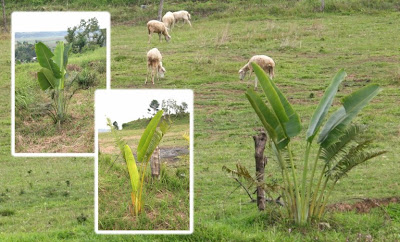The traveler sees what he sees, the tourist sees what he has come to see."
Gilbert K. Chesterton (1874-1936)
Gilbert K. Chesterton (1874-1936)
In my previous entry, "Another unplanned project", an ardent garden blogger and my cyberspace friend Andrea asked if I don't like the Traveler's Palm. Now who wouldn't like a gorgeous plant like the one below?
If there is a mad scientist who has successfully crossbred two unrelated plants, the Ravenala madagascariensis, commonly known as Traveler's (or Traveller's) Palm would be a good example of his sinister work. At first glance one would think it's a banana and a palm tree spliced together. The leaves resemble that of the banana and the trunk looks like that of a palm tree.
The banana-like leaves and petioles are symmetrically lined on a plane which extend out from a single trunk. This leaf and stalk arrangement gives it a very beautiful hand fan appearance. Like a palm tree, the Traveler's palm has a single sturdy trunk. The trunk of the young plant is hidden below ground level but as the plant grows it sheds its dead leaf, slowly revealing the trunk with its distinctive leaf scar rings, another characteristic of true palms.
We have several of the Traveler's palm in the garden. None are as big and beautiful as the one in the first picture above, but given time and proper care they too will look the same.

One of our Traveler's palm with most of its leaves chopped off due to severe damage caused by a strong typhoon.
The last big storm to hit the farm last year has been brutal to these plants as demonstrated by their tattered leaves. But new leaves have sprouted since then. Our biggest Traveler's palm which is at the entrance to the farm (right picture) suffered the most lashing. It successfully held its ground but got severely beaten in the process. Most of its older leaves have been lopped off as they have been completely damaged. Now it faces a new trial since it will be dug up and transplanted inside to make way for the Triangle palms. I hope it will survive this impending transplant.
Because of its unique appearance the Traveler's palm has indeed traveled from its native place of Madagascar to see and conquer other parts of the world and will not fail to catch the eye of anyone who visits a garden with a tropical landscape theme.



